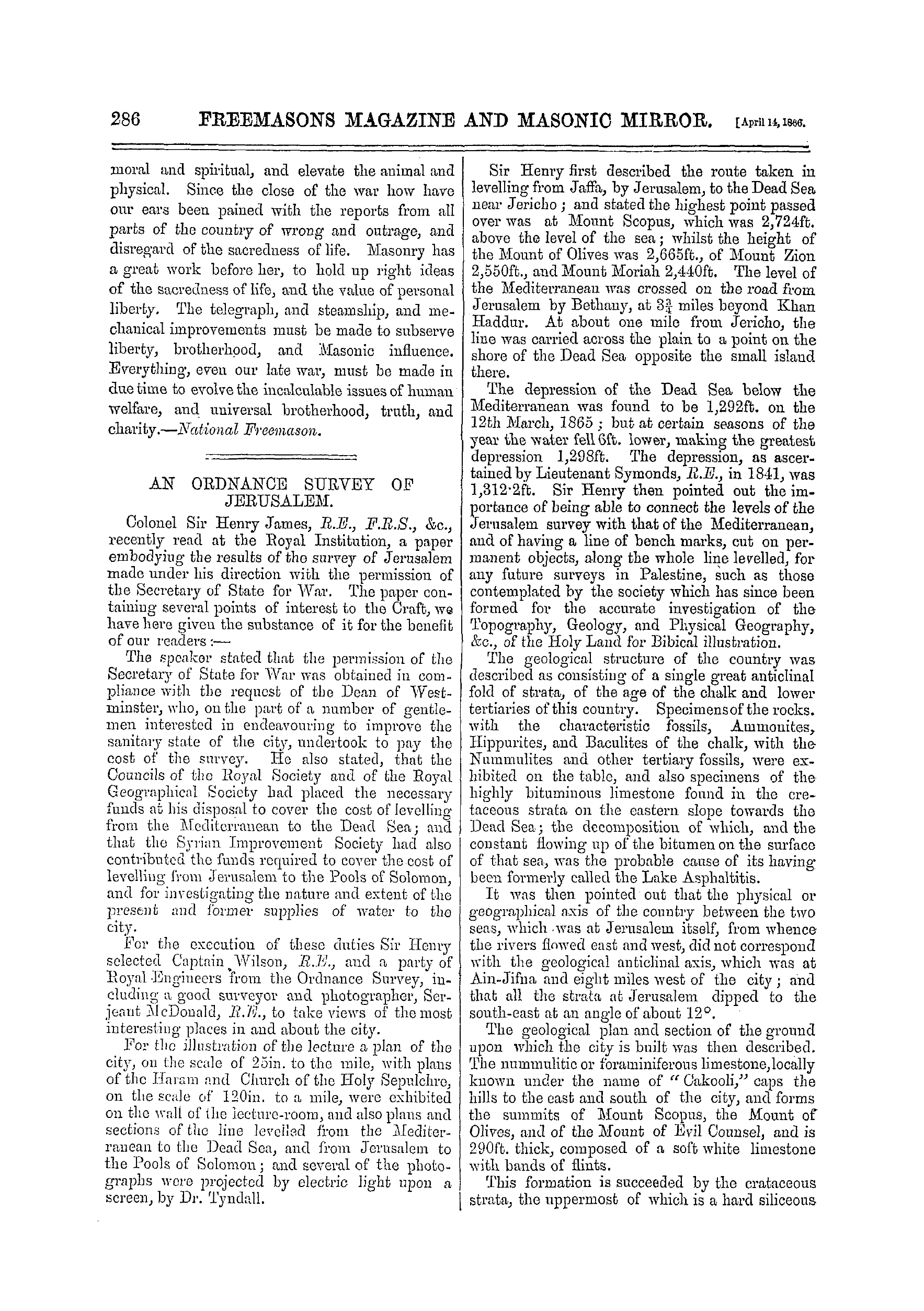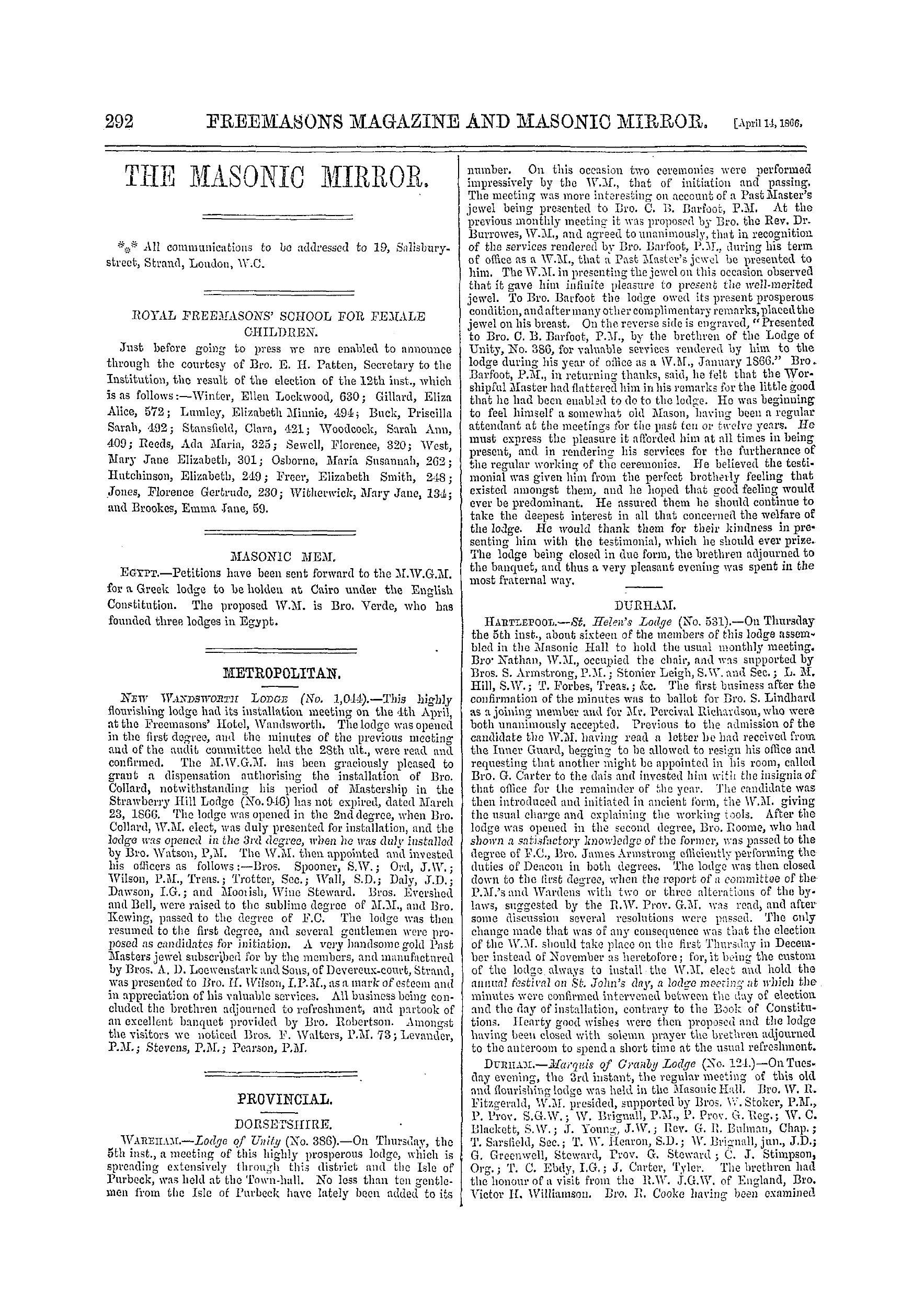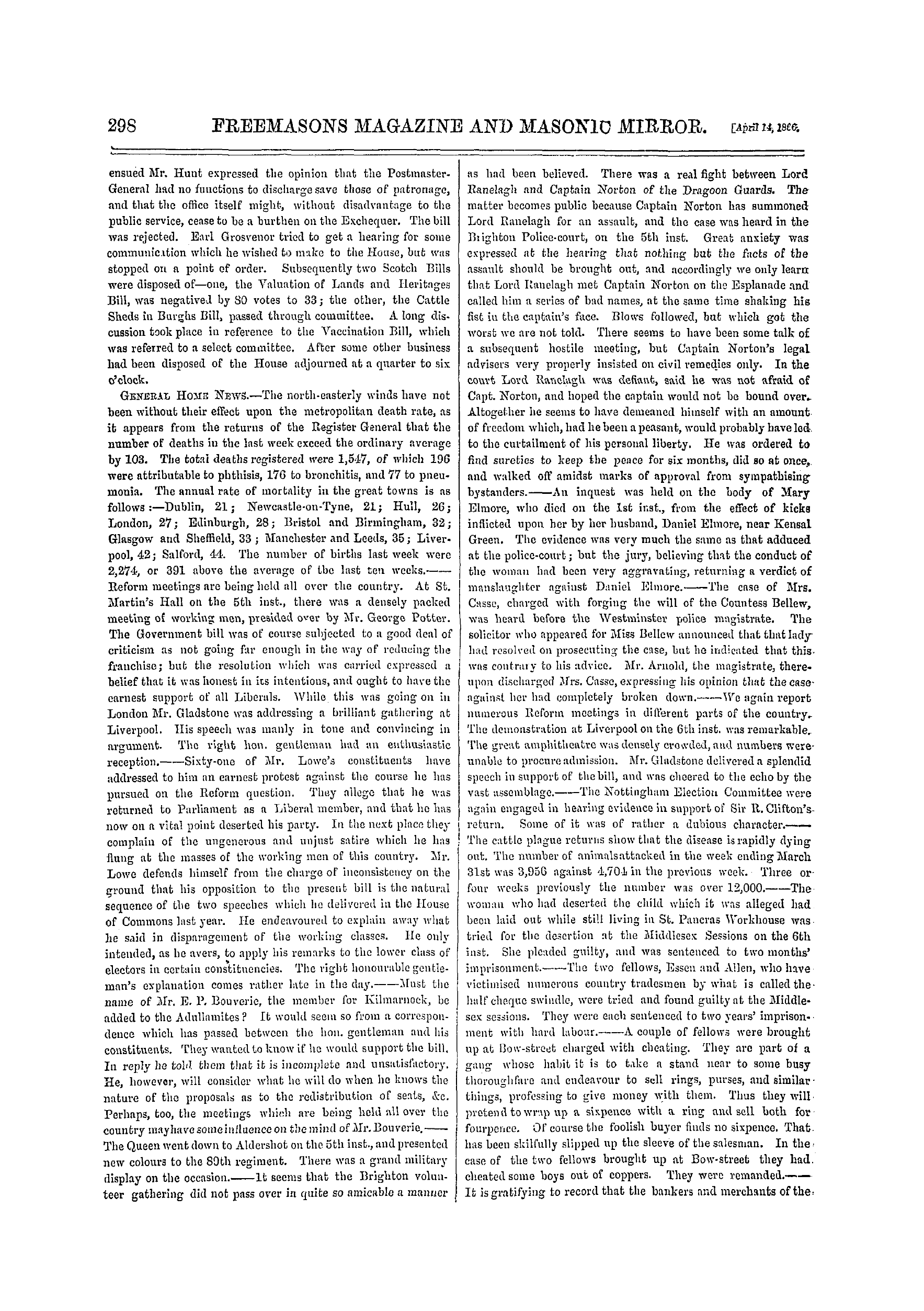Note: This text has been automatically extracted via Optical Character Recognition (OCR) software.
Ar00800
The Mahometan quarter occupies the north-east portion of the city , and includes the Haram es Sherif . The JeAvish quarter is on the south , between the Armenian Quarter and the Haram . Sir Henry then described the present and the ancient means of supplying the city with water . Of
the drainage of the city , lie said , there is none in our acceptation of the Avord , as there is not a single drain leading from the city ; and the present AA ater supply is derived principally from the cisterns in which the rain water is collected , and from Joab ' s fountain , from Avhence it is brought in skins on
the backs of donkeys , aud sold in the city . The water from the Pool of Siloam , although described by Josephus as sweet and in great plenty , is IIOAV extremely impure and in small quantity . The ancient conduits for the supply of water Avere remarkable as engineering Avorks , and rivalled those
Avhich have been most recently executed in this country by our most skilful engineers , such as those executed for supplying the city of Glasgow . Two conduits Avere described and distinguished as the high level and the low level conduits . The IOAV level conduit Avas brought from a great distance by the Wady Urtas to below the lowest of the three Pools of Solomon , and from thence passing
through two tunnels , was led round the lower Pool of Gihon , and round the south end of Mount Zion into the city at the Avest side of Tyropean . valley , at an altitude of 2 , 420 feet . The high level conduit Avas brought from a valley to the south of the Pools of Solomon , aud led , after
passing through a tunnel , above the uppermost of the pools ; and from thence by Rachel's Tomb , crossing a A alley by means of a syphon made of stone , in lengths of about 5 feet , and having collar aud socket joints to connect them , it AAVIS led round the upper Pool of Gihon into the Citadel at
an altitude of 2 , 528 ft . or 108 ft . above the level at Avhich the lower conduit entered the city , and at a suineient height to supply every house in the city with Avater . By this arrangement the lower conduit could be supplied with water either through the Pools of Solomon or through pipes in the city .
The IOAV level conduit Avas supposed to be that which is referred to by Josephus in his " Antiquities of the JOAVS , " Book xviii ., chap . 3 , AAdiere he says : —7 " Pilate , the Procurator of Judea , undertook to bring a current of water to Jerusalem , aud did it with the sacred money , and derived the origin of the stream from the distance of 200 fnrlons'S . "
In the Tyropean valley there are three beautiful fountains , Avhich are referred to by Moryson , Avho visited Jerusalem in 1596 , Avho says , AAdien describing tins part of the city , " Here I did see pleasant fountains of waters ; " but there is no water to supply them UOAV .
His Royal Highness Prince Arthur examined a stone syphon , similar to that described nenr Patara , in Lycia , of which a sketch by Major Elphinstone ,
R . E ., Avas exhibited , as well as models of portions of the tAvo syphons . The Holy Sepulchre was described as a small chamber or crypt , about 6 ft . square and 9 ft . high , having on the east side so very IOAV an entrance as to oblige people to stoop down in going in or
out . It lies exactly east and west , and has a bench on the north side , and to the right of the entrance , on Avhich the body of our Saviour was laid .
This Avas originally a tomb cut out of the solid rock in the side of the hill , but the Emperor Constantine , A . D . 333 , had the rock around it cut away , so as to leaA-e the tomb standing out by itself . He then encased the tomb Avith marble , and richly ornamented it , and surrounded it with
a large open court , paved with marble , and built the Church of the Holy Sepulchre to the east of it . An examination of the ground fully sustains thedescriptions which have been given by the contemporary Avriters , Eusebius and Jerome , and by the Pilgrim of Bordeauxboth as to the Sepulchre
, itself and its site . The Sepulchre is surrounded by a handsomecircular building - , with a dome open at the top ; but it much needs the repairs which the Empress of the French is exerting herself to obtain the funds to effect . The Greek church , the principal
of the many grouped lound the sepulchre , is immediately to the east of the sepulchre , aud in the position of the one built by Constantine . Calvary is 140 ffc . S . E . of the sepulchre . The Haram es Sherif , or Noble Sanctuary , was described as a quadrilateral enclosure of 35 acres ,
and nearly one mile in circuit , the northern side being 1 , 042 ft . long , the eastern 1 , 530 , the southern 922 , and the western 1 , 601 .
The magnificent Dome of the Rock or Mosque of Omar , as it is commonly called , stands on a platform a little to the Avest of the centre of the area , and was built A . D . 688 to 691 , and restored in the 16 th century by Solimau the Magnificent ; it is erected over and around the Sakhrah . The Sakrhah is a portion of the natural rock—in fact , the summit of Mount Moriah , the highest portion of Avhich is 4 ft . 9 iin . above the marble floor of the
mosque , and it is 2 , 440 ft . above the level of the sea . Beneath the Sakhrah there is a cave which is entered by descending some steps on the southeast side . The cave itself is about 9 ft . high in the highest partand 22 ft . 6 in . square ; a hole has
, been cut through from the upper surface of the rock into the chamber beneath , and there is a corresponding hole immediately under it , Avhich leads to a drain down to the vallev of the Kedron ..
The hole is supposed to haA r e been made for the purpose of carrying off the blood of the animals sacrificed on the rock , AAdien it Avas the altar of burnt-offerings to the Temple . The Mosque , a splendid specimen of Saracenic architecture , consists of a very elegantly-shaped
Note: This text has been automatically extracted via Optical Character Recognition (OCR) software.
Ar00800
The Mahometan quarter occupies the north-east portion of the city , and includes the Haram es Sherif . The JeAvish quarter is on the south , between the Armenian Quarter and the Haram . Sir Henry then described the present and the ancient means of supplying the city with water . Of
the drainage of the city , lie said , there is none in our acceptation of the Avord , as there is not a single drain leading from the city ; and the present AA ater supply is derived principally from the cisterns in which the rain water is collected , and from Joab ' s fountain , from Avhence it is brought in skins on
the backs of donkeys , aud sold in the city . The water from the Pool of Siloam , although described by Josephus as sweet and in great plenty , is IIOAV extremely impure and in small quantity . The ancient conduits for the supply of water Avere remarkable as engineering Avorks , and rivalled those
Avhich have been most recently executed in this country by our most skilful engineers , such as those executed for supplying the city of Glasgow . Two conduits Avere described and distinguished as the high level and the low level conduits . The IOAV level conduit Avas brought from a great distance by the Wady Urtas to below the lowest of the three Pools of Solomon , and from thence passing
through two tunnels , was led round the lower Pool of Gihon , and round the south end of Mount Zion into the city at the Avest side of Tyropean . valley , at an altitude of 2 , 420 feet . The high level conduit Avas brought from a valley to the south of the Pools of Solomon , aud led , after
passing through a tunnel , above the uppermost of the pools ; and from thence by Rachel's Tomb , crossing a A alley by means of a syphon made of stone , in lengths of about 5 feet , and having collar aud socket joints to connect them , it AAVIS led round the upper Pool of Gihon into the Citadel at
an altitude of 2 , 528 ft . or 108 ft . above the level at Avhich the lower conduit entered the city , and at a suineient height to supply every house in the city with Avater . By this arrangement the lower conduit could be supplied with water either through the Pools of Solomon or through pipes in the city .
The IOAV level conduit Avas supposed to be that which is referred to by Josephus in his " Antiquities of the JOAVS , " Book xviii ., chap . 3 , AAdiere he says : —7 " Pilate , the Procurator of Judea , undertook to bring a current of water to Jerusalem , aud did it with the sacred money , and derived the origin of the stream from the distance of 200 fnrlons'S . "
In the Tyropean valley there are three beautiful fountains , Avhich are referred to by Moryson , Avho visited Jerusalem in 1596 , Avho says , AAdien describing tins part of the city , " Here I did see pleasant fountains of waters ; " but there is no water to supply them UOAV .
His Royal Highness Prince Arthur examined a stone syphon , similar to that described nenr Patara , in Lycia , of which a sketch by Major Elphinstone ,
R . E ., Avas exhibited , as well as models of portions of the tAvo syphons . The Holy Sepulchre was described as a small chamber or crypt , about 6 ft . square and 9 ft . high , having on the east side so very IOAV an entrance as to oblige people to stoop down in going in or
out . It lies exactly east and west , and has a bench on the north side , and to the right of the entrance , on Avhich the body of our Saviour was laid .
This Avas originally a tomb cut out of the solid rock in the side of the hill , but the Emperor Constantine , A . D . 333 , had the rock around it cut away , so as to leaA-e the tomb standing out by itself . He then encased the tomb Avith marble , and richly ornamented it , and surrounded it with
a large open court , paved with marble , and built the Church of the Holy Sepulchre to the east of it . An examination of the ground fully sustains thedescriptions which have been given by the contemporary Avriters , Eusebius and Jerome , and by the Pilgrim of Bordeauxboth as to the Sepulchre
, itself and its site . The Sepulchre is surrounded by a handsomecircular building - , with a dome open at the top ; but it much needs the repairs which the Empress of the French is exerting herself to obtain the funds to effect . The Greek church , the principal
of the many grouped lound the sepulchre , is immediately to the east of the sepulchre , aud in the position of the one built by Constantine . Calvary is 140 ffc . S . E . of the sepulchre . The Haram es Sherif , or Noble Sanctuary , was described as a quadrilateral enclosure of 35 acres ,
and nearly one mile in circuit , the northern side being 1 , 042 ft . long , the eastern 1 , 530 , the southern 922 , and the western 1 , 601 .
The magnificent Dome of the Rock or Mosque of Omar , as it is commonly called , stands on a platform a little to the Avest of the centre of the area , and was built A . D . 688 to 691 , and restored in the 16 th century by Solimau the Magnificent ; it is erected over and around the Sakhrah . The Sakrhah is a portion of the natural rock—in fact , the summit of Mount Moriah , the highest portion of Avhich is 4 ft . 9 iin . above the marble floor of the
mosque , and it is 2 , 440 ft . above the level of the sea . Beneath the Sakhrah there is a cave which is entered by descending some steps on the southeast side . The cave itself is about 9 ft . high in the highest partand 22 ft . 6 in . square ; a hole has
, been cut through from the upper surface of the rock into the chamber beneath , and there is a corresponding hole immediately under it , Avhich leads to a drain down to the vallev of the Kedron ..
The hole is supposed to haA r e been made for the purpose of carrying off the blood of the animals sacrificed on the rock , AAdien it Avas the altar of burnt-offerings to the Temple . The Mosque , a splendid specimen of Saracenic architecture , consists of a very elegantly-shaped



















